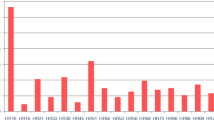Abstract
Breast cancer is one of the most frequently diagnosed cancers in women in France, but its aetiology remains unknown. Viruses including Epstein-Barr virus (EBV), a human equivalent of murine mammary tumour virus (MMTV) and human papillomavirus (HPV) have been detected in benign breast tissues and breast tumours and are considered to be involved in the aetiology of breast cancer. The aim of this study was to determine the prevalence of high-risk oncogenic HPVs in breast carcinoma from French patients. Fifty unselected DNA samples extracted from invasive breast carcinoma tissues were analysed. Polymerase chain reaction (PCR) was performed to amplify both consensus GP5 + /GP6 + HPV sequences and specific sequences for HPV types 16, 18, 33, 45 and 6-11. No HPV-DNA sequences were detected in our series of 50 samples. These data argue against the role of oncogenic HPV in the pathogenesis of breast cancer.
Similar content being viewed by others
References
Magrath I, Bhatia K (1999) Breast cancer: a new Epstein-Barr virus-associated disease? J Natl Cancer Inst 91:1349–1350
Wong M, Pagano JS, Schiller JT, Tevethia SS, Raab-Traub N, Gruber J (2002) New associations of human papillomavirus, Simian virus 40, and Epstein-Barr virus with human cancer. J Natl Cancer Inst 94:1832–1836
Arbach H, Viglasky V, Lefeu F, Guinebretiere JM, Ramirez V, Bride N, Boualaga N, Bauchet T, Peyrat JP, Mathieu MC, Mourah S, Podgorniak MP, Seignerin JM, Takada K, Joab I (2006) Epstein-Barr virus (EBV) genome and expression in breast cancer tissue: effect of EBV infection of breast cancer cells on resistance to paclitaxel (Taxol). J Virol 80:845–853
Wang Y, Pelisson I, Melana SM, Go V, Holland JF, Pogo BG (2001) MMTV-like env gene sequences in human breast cancer. Arch Virol 146:171–180
Zammarchi F, Pistello M, Piersigilli A, Murr R, Di Cristofano C, Naccarato AG, Bevilacqua G (2006) MMTV-like sequences in human breast cancer: a fluorescent PCR/laser microdissection approach. J Pathol 209:436–444
Zangen R, Harden S, Cohen D, Parrella P, Sidransky D (2002) Mouse mammary tumor-like env gene as a molecular marker for breast cancer? Int J Cancer 102:304–307
Witt A, Hartmann B, Marton E, Zeillinger R, Schreiber M, Kubista E (2003) The mouse mammary tumor virus-like env gene sequence is not detectable in breast cancer tissue of Austrian patients. Oncol Rep 10:1025–1029
Kan CY, Iacopetta BJ, Lawson JS, Whitaker NJ (2005) Identification of human papillomavirus DNA gene sequences in human breast cancer. Br J Cancer 93:946–948
Di Lonardo A, Venuti A, Marcante ML (1992) Human papillomavirus in breast cancer. Breast Cancer Res Treat 21:95–100
Hennig EM, Nesland JM, Di Lonardo A, Venuti A (1999) Multiple primary cancers and HPV infection: are they related? J Exp Clin Cancer Res 18:53–54
Hennig EM, Suo Z, Thoresen S, Holm R, Kvinnsland S, Nesland JM (1999) Human papillomavirus 16 in breast cancer of women treated for high grade cervical intraepithelial neoplasia (CIN III). Breast Cancer Res Treat 53:121–135
Yu Y, Morimoto T, Sasa M, Okazaki K, Harada Y, Fujiwara T, Irie Y, Takahashi E, Tanigami A, Izumi K (2000) Human papillomavirus type 33 DNA in breast cancer in Chinese. Breast Cancer 7:33–36
Li T, Lu ZM, Guo M, Wu QJ, Chen KN, Xing HP, Mei Q, Ke Y (2002) p53 codon 72 polymorphism (C/G) and the risk of human papillomavirus-associated carcinomas in China. Cancer 95:2571–2576
de Villiers EM, Sandstrom RE, zur Hausen H, Buck CE (2005) Presence of papillomavirus sequences in condylomatous lesions of the mamillae and in invasive carcinoma of the breast. Breast Cancer Res 7:R1–R11
Damin AP, Karam R, Zettler CG, Caleffi M, Alexandre CO (2004) Evidence for an association of human papillomavirus and breast carcinomas. Breast Cancer Res Treat 84:131–137
Wrede D, Luqmani YA, Coombes RC, Vousden KH (1992) Absence of HPV 16 and 18 DNA in breast cancer. Br J Cancer 65:891–894
Gopalkrishna V, Singh UR, Sodhani P, Sharma JK, Hedau ST, Mandal AK, Das BC (1996) Absence of human papillomavirus DNA in breast cancer as revealed by polymerase chain reaction. Breast Cancer Res Treat 39:197–202
Bratthauer GL, Tavassoli FA, O’Leary TJ (1992) Etiology of breast carcinoma: no apparent role for papillomavirus types 6/11/16/18. Pathol Res Pract 188:384–386
Ridolfi RL, Rosen PP, Port A, Kinne D, Mike V (1977) Medullary carcinoma of the breast: a clinicopathologic study with 10 year follow-up. Cancer 40:1365–1385
Lombard I, Vincent-Salomon A, Validire P, Zafrani B, de la Rochefordiere A, Clough K, Favre M, Pouillart P, Sastre-Garau X (1998) Human papillomavirus genotype as a major determinant of the course of cervical cancer. J Clin Oncol 16:2613–2619
de Cremoux P, Thioux M, Peter M, Vielh P, Michon J, Delattre O, Magdelenat H (1997) Polymerase chain reaction compared with dot blotting for the determination of N-myc gene amplification in neuroblastoma. Int J Cancer 72:518–521
de Roda Husman AM, Walboomers JM, van den Brule AJ, Meijer CJ, Snijders PJ (1995) The use of general primers GP5 and GP6 elongated at their 3′ ends with adjacent highly conserved sequences improves human papillomavirus detection by PCR. J Gen Virol 76(Pt 4):1057–1062
Kroupis C, Markou A, Vourlidis N, Dionyssiou-Asteriou A, Lianidou ES (2006) Presence of high-risk human papillomavirus sequences in breast cancer tissues and association with histopathological characteristics. Clin Biochem 39:727–731
Widschwendter A, Brunhuber T, Wiedemair A, Mueller-Holzner E, Marth C (2004) Detection of human papillomavirus DNA in breast cancer of patients with cervical cancer history. J Clin Virol 31:292–297
Liu Y, Klimberg VS, Andrews NR, Hicks CR, Peng H, Chiriva-Internati M, Henry-Tillman R, Hermonat PL (2001) Human papillomavirus DNA is present in a subset of unselected breast cancers. J Hum Virol 4:329–334
Acknowledgements
We thank P. Mandé for typing the manuscript.
Author information
Authors and Affiliations
Consortia
Corresponding author
Rights and permissions
About this article
Cite this article
de Cremoux, P., Thioux, M., Lebigot, I. et al. No evidence of Human papillomavirus DNA sequences in invasive breast carcinoma. Breast Cancer Res Treat 109, 55–58 (2008). https://doi.org/10.1007/s10549-007-9626-4
Received:
Accepted:
Published:
Issue Date:
DOI: https://doi.org/10.1007/s10549-007-9626-4




